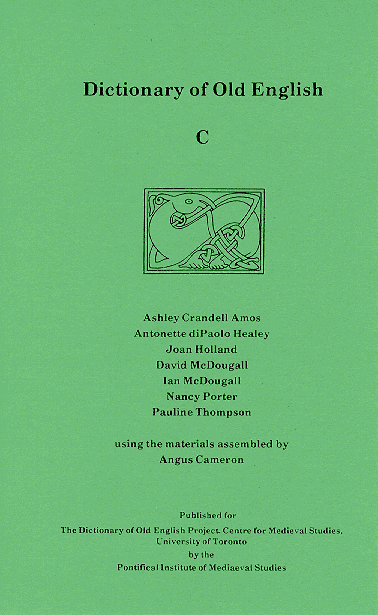1988 – 6 fiche. ISBN 0-88844-925-9 $8.95
Order from the Pontifical Institute of Mediaeval Studies (PIMS)
The second fascicle of the Dictionary of Old English, the letter C, consists of 1,367 headwords in 1,610 pages on microfiche. The material on which C is based represents a fresh look at all surviving Old English (except multiple copies of texts), an estimated three million running words.
Although the Dictionary of Old English is meant to serve as a bilingual translation dictionary, it is also a historical dictionary, an inventory and description of the English language from its earliest appearance in written records, ca. 600. It is intended to complement the Oxford English Dictionary for the earliest period of the language; indeed, the Dictionary of Old English will catalogue the Old English vocabulary deliberately excluded from the OED because it failed to survive past 1150.
The Dictionary draws on as wide a range of texts — in date, dialect and genre — as possible. It differs from previous dictionaries in several important features: a listing in a simplified paradigmatic order of every spelling which is attested for a word in the Electronic Corpus; frequency counts for each word in the Corpus so that readers can know what proportion of the evidence has been cited; usage labels where they are statistically significant, noting restrictions to a class of texts, to an author, or to a particular period or dialect; exhaustive citation for all words of twelve or fewer occurrences.
The first fascicle of the Dictionary of Old English, the letter D, was published in 1986 (4 fiche). Fascicle Cwaspublished in 1988 (6 fiche). A Preface to Readers, included in booklet form, supplements the information on principles and practices which accompanied Fascicle D.
Fascicle C was prepared by Ashley Crandell Amos and Antonette diPaolo Healey (co-editors), Joan Holland, David McDougall, Ian McDougall, Nancy Porter, and Pauline Thompson, using materials assembled by the late Angus Cameron.
